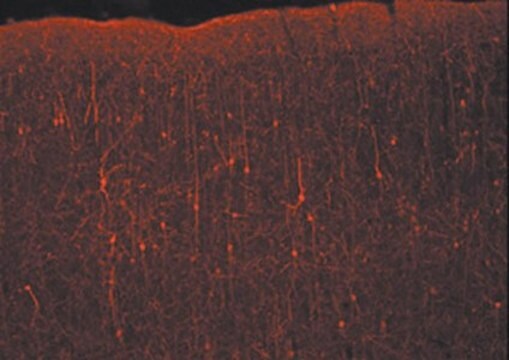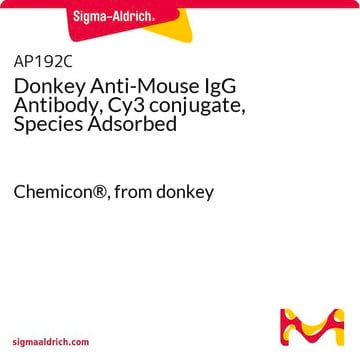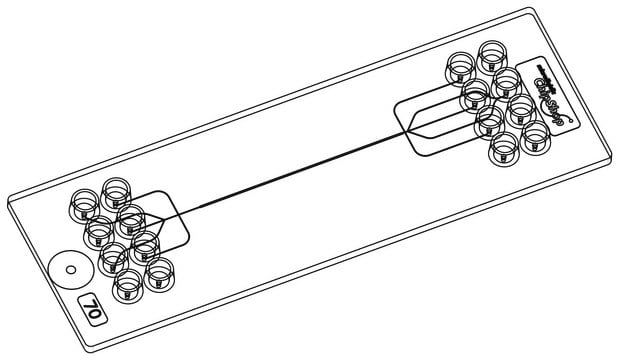AP192F
Donkey Anti-Mouse IgG Antibody, FITC conjugate, Species Adsorbed
Chemicon®, from donkey
Faça loginpara ver os preços organizacionais e de contrato
About This Item
Código UNSPSC:
12352203
eCl@ss:
32160702
NACRES:
NA.46
Produtos recomendados
fonte biológica
donkey
Nível de qualidade
conjugado
FITC conjugate
forma do anticorpo
affinity purified immunoglobulin
tipo de produto de anticorpo
secondary antibodies
clone
polyclonal
reatividade de espécies
mouse
fabricante/nome comercial
Chemicon®
técnica(s)
immunofluorescence: suitable
Condições de expedição
wet ice
modificação pós-traducional do alvo
unmodified
Categorias relacionadas
Descrição geral
Immunoglobulin G (IgG), is one of the most abundant proteins in human serum with normal levels between 8-17 mg/mL in adult blood. IgG is important for our defence against microorganisms and the molecules are produced by B lymphocytes as a part of our adaptive immune response. The IgG molecule has two separate functions; to bind to the pathogen that elicited the response and to recruit other cells and molecules to destroy the antigen. The variability of the IgG pool is generated by somatic recombination and the number of specificities in an individual at a given time point is estimated to be 1011 variants.
Especificidade
Specific for Mouse IgG.
Aplicação
Detect Donkey Mouse IgG using this Donkey anti-Mouse IgG Antibody, FITC conjugate, Species Adsorbed validated for use in IF.
Research Category
Secondary & Control Antibodies
Secondary & Control Antibodies
Research Sub Category
Secondary Antibodies Adsorbed for Dual Labeling
Secondary Antibodies Adsorbed for Dual Labeling
Suggested dilution for most applications: 1:50-1:200.
Optimal working dilutions must be determined by the end user.
Optimal working dilutions must be determined by the end user.
forma física
ImmunoAffinity Purified
Lyophilized. Buffer = 0.02 M Sodium Phosphate, 0.25 M NaCl, pH 7.6, with 15 mg/mL BSA and 0.1% sodium azide.
RECONSTITUTION:
Reconstitute to 1 mg/mL with sterile distilled water.
F/P RATIO:
15 micrograms FITC per mg of antibody.
RECONSTITUTION:
Reconstitute to 1 mg/mL with sterile distilled water.
F/P RATIO:
15 micrograms FITC per mg of antibody.
Armazenamento e estabilidade
Maintain lyophilized product at 2–8°C for up to 12 months. After reconstitution the product is stable for several weeks at 2–8°C as an undiluted liquid. For extended storage after reconstitution, add an equal volume of glycerol to make a final concentration of 50% glycerol followed by storage at -20°C in undiluted aliquots for up to 12 months. Please note the concentration of protein (and buffer salts) will decrease to one-half of the original after the addition of glycerol. Avoid repeated freeze/thaw cycles.
Informações legais
CHEMICON is a registered trademark of Merck KGaA, Darmstadt, Germany
Exoneração de responsabilidade
Unless otherwise stated in our catalog or other company documentation accompanying the product(s), our products are intended for research use only and are not to be used for any other purpose, which includes but is not limited to, unauthorized commercial uses, in vitro diagnostic uses, ex vivo or in vivo therapeutic uses or any type of consumption or application to humans or animals.
Not finding the right product?
Try our Ferramenta de seleção de produtos.
Frases de perigo
Declarações de precaução
Classificações de perigo
Aquatic Chronic 3
Código de classe de armazenamento
11 - Combustible Solids
Classe de risco de água (WGK)
WGK 3
Certificados de análise (COA)
Busque Certificados de análise (COA) digitando o Número do Lote do produto. Os números de lote e remessa podem ser encontrados no rótulo de um produto após a palavra “Lot” ou “Batch”.
Já possui este produto?
Encontre a documentação dos produtos que você adquiriu recentemente na biblioteca de documentos.
Ryosuke Saigusa et al.
Proceedings of the National Academy of Sciences of the United States of America, 112(49), 15136-15141 (2015-11-26)
Systemic sclerosis (SSc) is a multisystem autoimmune disorder with clinical manifestations resulting from tissue fibrosis and extensive vasculopathy. A potential disease susceptibility gene for SSc is IFN regulatory factor 5 (IRF5), whose SNP is associated with milder clinical manifestations; however
Chia-Chieh Chang et al.
Journal of endodontics, 46(9), 1256-1264 (2020-06-09)
Biomaterials designed for tissue engineering should be nontoxic and nonimmunogenic and should achieve their intended functions. Treated dentin matrix (TDM), a bioactive extracellular matrix, is promising for tooth regeneration. However, the effect of sterilization on the surface properties of allogenous
Weihua Guo et al.
Cell transplantation, 23(2), 181-194 (2013-02-01)
Cell transplantation has emerged as a novel therapeutic strategy for periodontitis, and the adoption of cell pellet offers advantages by secreting abundant extracellular matrix (ECM) and eliminating the adverse effect of cell carriers. This study aimed to fabricate scaffold-free periodontal
Lotta E Oikari et al.
Data in brief, 7, 206-215 (2016-03-10)
Neural stem cells (NSCs) and neural progenitor cells (NPCs) are self-renewing and multipotent cells, however, NPCs are considered to be more lineage-restricted with a reduced self-renewing capacity. We present data comparing the expression of 21 markers encompassing pluripotency, self-renewal (NSC)
Integrins mediate adherence and migration of T lymphocytes on human peritoneal mesothelial cells.
Wang, HH; Lee, TY; Lin, CY
Kidney International null
Nossa equipe de cientistas tem experiência em todas as áreas de pesquisa, incluindo Life Sciences, ciência de materiais, síntese química, cromatografia, química analítica e muitas outras.
Entre em contato com a assistência técnica







